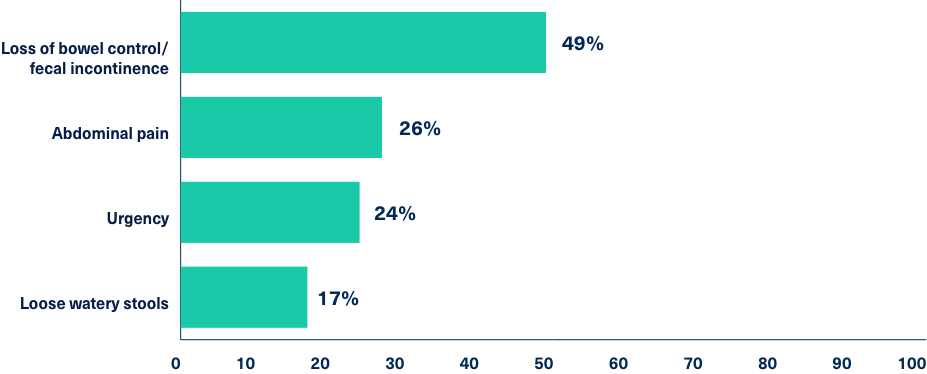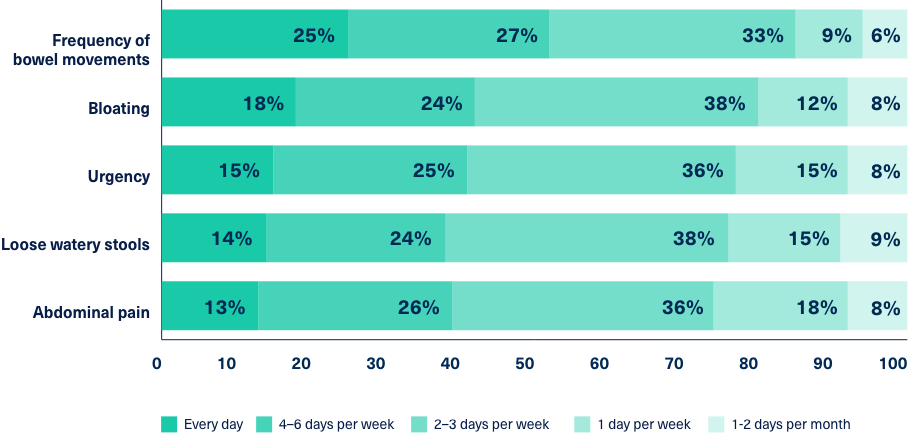IBS-D comprises multiple symptoms, but it is identified clinically by its dominant features of abdominal pain and diarrhea. In addition, patients with IBS-D typically experience urgency and bloating.1 While patients strongly desire improved symptom management, they often don’t clearly communicate the full extent of their condition due to focusing only on the loose stools instead of the multitude of abdominal symptoms. In addition to an open dialogue, the Patient Discussion Guide can be used to educate patients and help classify abnormal bowel movements.2
MILLIONS EXPERIENCE SYMPTOMS NEARLY EVERY DAY
IBS-D IS A NEVER-ENDING CYCLE OF unpredictable and bothersome SYMPTOMS2
Recurrent diarrhea and abdominal pain are the main symptoms of IBS-D. People with IBS-D often experience disruptive symptoms, including cramping, frequent bowel movements, urgency, bloating, and loss of bowel control/fecal incontinence.2,4,5
When patients with IBS-D were asked to rank their most bothersome and frequent symptoms, they responded:2
Most Bothersome Symptoms in Adults with IBS-D2*

Many IBS-D Patients Suffer from Symptoms Nearly Every Day2*

Impact of IBS-D symptoms on daily living

More than 80% of people with IBS-D avoid situations where there’s no bathroom nearby.4*

Nearly 70% of people with IBS-D report they do not feel normal or "like myself."4*
For many patients with IBS-D, the physical and emotional impact of their condition are intertwined. Urgency and frequency associated with IBS-D frustrate many patients, interrupting their ability to participate in professional and personal relationships. More than 50% of patients with severe IBS-D symptoms report being constantly worried about when symptoms would return.6 Those with IBS-D reported significant disruption in daily activities and ability to interact in social situations.7
IBS-D PATIENTS WANT APPROPRIATE TREATMENT1
Downloadable Resources for You and Your Patients
An open dialogue focused on understanding the patient’s most bothersome symptoms may help reduce treatment delays and improve treatment expectations. The resources here are designed to help start the conversation and help with patient education and treatment management.
I HAVE PROBLEMS WITH DIARRHEA AND MAJOR CRAMPS. I HAVE BEEN SCARED TO LEAVE MY HOUSE AND I DON’T GO VERY FAR FROM HOME DUE TO THE WORRY OF IBS ACTING UP.8
THE IBS-D PROBLEMS HAVE BEEN GETTING MUCH WORSE. I CANNOT DO ANYTHING WITHOUT THE FEAR OF HAVING AN ACCIDENT. SO MANY MILESTONES IN MY LIFE HAVE BEEN RUINED FOR ME BECAUSE OF MY PROBLEMS.8
IBS IS MY LIVING HELL. I HATE IT SO MUCH.8